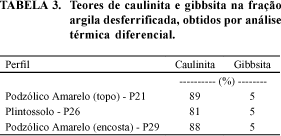Soils of the coastal plains of the Espírito Santo state, Brazil, were studied with the objective of investigating and interrelationing their mineralogical, chemical and micromorphological characteristics and to furnish subsides for the pedogenetic environment reconstruction. Eleven soil profiles were described, collected and analysed. Less crystalline Fe by acid ammonium oxalate and amorphous Si by NaOH 0.5 mol L-1 were also determined. On mottles and nodules samples the proportion of hematite and goethite and Al substitution in goethite were analysed. Mineralogical analyses were performed through optical methods, X-ray diffraction and differential thermal analysis. From undisturbed samples of subsuperficial horizons thin sections were prepared for micromorphological analysis. It was found that the present pedogenetic environment is favoring kaolinite stabilization and goethite formation, removing hematite and being probably responsible for the yellowing (xanthization) of superficial horizons. The process of iron segregation is evidenced by its accumulation in nodules and mottles in relation to soil matrix, probably by diffusion, the source being the matrix. The red nodules and mottles are in process of destruction instead of formation. The iron droplets which frequently occur in the interior of nodules and concretions constitute a stage of the process of development of these structures.
yellow latosol; iron oxides; soil micromorphological features; soil genesis










